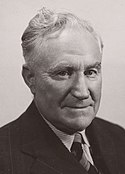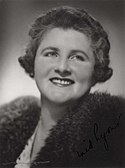Regierung Menzies IV
Die Regierung Menzies IV regierte Australien vom 19. Dezember 1949 bis zum 11. Mai 1951. Es handelte sich um eine Koalitionsregierung der Liberal Party (LP) und der Country Party (CP).
Bei der Parlamentswahl am 10. Dezember 1949 erlitt die regierende Labor Party eine Niederlage. Sie stellte nur noch 48 der 123 Abgeordneten im Repräsentantenhaus. Die Liberal Party erhielt 55, die Country Party 19 Mandate. Im Senat konnte Labor mit 33 von 60 Senatoren seine Mehrheit behaupten.[1] Die neue Regierung wurde von einer Koalition der Liberal Party und der Country Party gestellt. Premierminister wurde Robert Menzies, der das Amt schon von 1939 bis 1941 bekleidete.[2][3] Als Labor im Senat das Bankengesetz ablehnte, erreicht Menzies Neuwahlen für beide Parlamentskammern. Bei der Parlamentswahl am 28. April 1951 legte Labor leicht zu und erhielt 54 Sitze, die Liberal Party mit 57 Sitzen und die Country Party mit 17 Sitzen verloren leicht, die Regierung konnte aber ihre Mehrheit behaupten. Im Senat jedoch konnte die Regierung mit 32 der sechzig Mandate eine Mehrheit erringen.[4]
Ministerliste
| Amt | Minister | Partei | Amtszeit | Bild |
|---|---|---|---|---|
| Premierminister | Robert Menzies | LP | 19. Dezember 1949 – 11. Mai 1951 | 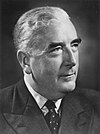 |
| Schatzminister | Arthur Fadden | CP | 19. Dezember 1949 – 11. Mai 1951 | 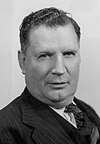 |
| Verteidigungsminister | Eric Harrison | LP | 19. Dezember 1949 – 24. Oktober 1950 |  |
| Philip McBride | LP | 24. Oktober 1950 – 11. Mai 1951 |  | |
| Minister für Nachkriegs-Wiederaufbau | Eric Harrison | LP | 19. Dezember 1949 – 17. März 1950 |  |
| Minister für Arbeit und Wehrpflicht | Harold Holt | LP | 19. Dezember 1949 – 11. Mai 1951 |  |
| Minister für Einwanderung | ||||
| Minister für Wirtschaft und Landwirtschaft | John McEwen | CP | 19. Dezember 1949 – 11. Mai 1951 | 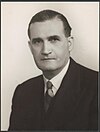 |
| Außenminister | Percy Spender | LP | 19. Dezember 1949 – 26. April 1951 |  |
| Richard Casey | LP | 27. April 1951 – 11. Mai 1951 |  | |
| Minister für die Außenterritorien | Percy Spender | LP | 19. Dezember 1949 – 26. April 1951 |  |
| Richard Casey | LP | 27. April 1951 – 11. Mai 1951 |  | |
| Minister für Bauen und Wohnraum | 19. Dezember 1949 – 11. Mai 1951 | |||
| Minister für Versorgung und Entwicklung | 19. Dezember 1949 – 17. März 1950 | |||
| Minister für nationale Entwicklung | 17. März 1950 – 11. Mai 1951 | |||
| Forschungsminister | 23. März 1950 – 11. Mai 1951 | |||
| Minister für Versorgung | Howard Beale | LP | 17. März 1950 – 11. Mai 1951 |  |
| Innenminister | Philip McBride | LP | 19. Dezember 1949 – 24. Oktober 1950 |  |
| Eric Harrison | LP | 24. Oktober 1950 – 11. Mai 1951 |  | |
| Gesundheitsminister | Earle Page | CP | 19. Dezember 1949 – 11. Mai 1951 |  |
| Minister für Handel und Zölle | Neil O’Sullivan | LP | 19. Dezember 1949 – 11. Mai 1951 |  |
| Minister für Schifffahrt und Treibstoff | George McLeay | LP | 19. Dezember 1949 – 17. März 1950 |  |
| Minister für Treibstoff, Schifffahrt und Verkehr | 17. März 1950 – 11. Mai 1951 | |||
| Minister für die Luftwaffe | Thomas White | LP | 19. Dezember 1949 – 11. Mai 1951 |  |
| Minister für die Luftfahrt | ||||
| Generalpostmeister | Hubert Lawrence Anthony | CP | 19. Dezember 1949 – 11. Mai 1951 |  |
| Armeeminister | Josiah Francis | LP | 19. Dezember 1949 – 11. Mai 1951 |  |
| Marineminister | ||||
| Generalstaatsanwalt | John Spicer | LP | 19. Dezember 1949 – 11. Mai 1951 |  |
| Vizepräsident des Executive Council | Enid Lyons | LP | 19. Dezember 1949 – 7. März 1951 |  |
| Robert Menzies | LP | 7. März 1951 – 11. Mai 1951 |  | |
| Sozialminister | Bill Spooner | LP | 19. Dezember 1949 – 11. Mai 1951 | 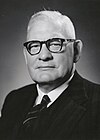 |
| Minister für Repatriierung | Walter Cooper | CP | 19. Dezember 1949 – 11. Mai 1951 |  |
| Informationsminister | Howard Beale | LP | 19. Dezember 1949 – 11. Mai 1951 |  |
| Verkehrsminister | 19. Dezember 1949 – 17. März 1950 |
Weblinks
- Parliamentary Handbook for the 45th Parliament. (PDF; 13,4 MB) Part 6: Historical information on the Australian Parliament – Ministries and Cabinets. Parliament of Australia, S. 538, abgerufen am 11. Mai 2019 (englisch).
Einzelnachweise
- ↑ Stephen Barber: Federal election results 1901–2016—Reissue 2. (PDF; 2,9 MB) Parliament of Australia, S. 9, 35, 140, abgerufen am 11. Mai 2019 (englisch).
- ↑ A. W. Martin: Menzies, Sir Robert Gordon (Bob) (1894–1978). In: Douglas Pike (Hrsg.): Australian Dictionary of Biography. Band 15. Melbourne University Press, Carlton (Victoria) 2000, ISBN 0-522-84843-5 (englisch).
- ↑ Johannes H. Voigt: Geschichte Australiens. Alfred Kröner, Stuttgart 1988, ISBN 3-520-48801-9, S. 259–262.
- ↑ Stephen Barber: Federal election results 1901–2016—Reissue 2. (PDF; 2,9 MB) Parliament of Australia, S. 9, 36, 140, abgerufen am 11. Mai 2019 (englisch).
Auf dieser Seite verwendete Medien
Commonwealth Coat of Arms of Australia granted by Royal Warrant signed by King George V on 19 September 1912.
IMPORTANT:This image is an artist's interpretation of the original (1912) official version of the Commonwealth Coat of Arms shown in Commons on the Australian coat of arms page. A variant of the original, with a transparent background, is shown on this page.
| “ | Quarterly of six, the first quarter Argent a Cross Gules charged with a Lion passant guardant between on each limb a Mullet of eight points Or; the second Azure five Mullets, one of eight, two of seven, one of six and one of five points of the first (representing the Constellation of the Southern Cross) ensigned with an Imperial Crown proper; the third of the first a Maltese Cross of the fourth, surmounted by a like Imperial Crown; the fourth of the third, on a Perch wreathed Vert and Gules an Australian Piping Shrike displayed also proper; the fifth also Or a Swan naiant to the sinister Sable; the last of the first, a Lion passant of the second, the whole within a Bordure Ermine; for the Crest on a Wreath Or and Azure A Seven-pointed Star Or, and for Supporters dexter a Kangaroo, sinister an Emu, both proper. | ” |
Title: Washington, D.C. The Australian Legation. Minister Casey in his chancery office
[Personal Papers of Prime Minister Holt] Portrait of Harold Holt, Canberra, 1953
Percy Spender (1897-1985), Australian politician and ambassador to the United States as well as judge (1958-1967) and president (1964-1967) of the International Court of Justice.
Autographed photographic portrait of Dame Enid Lyons
John McEwen in 1950










